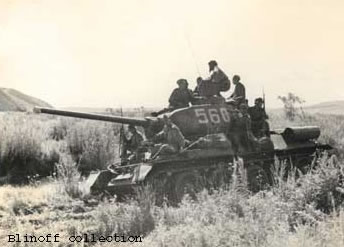The Manchurian Strategic Offensive Operation, also known as Operation August Storm, was a Soviet campaign against the Japanese that began in August 1945. Along with the atomic bombings of Hiroshima and Nagasaki by the United States, the Manchurian Strategic Defensive Operation helped to force the Japanese to surrender at the end of World War II.
On April 13, 1941, Japan and the USSR had signed a non-aggression pact that was supposed to remain in force until the same day in 1946.
On April 5, 1945, the USSR informed Japan that it would not be renewing the pact.
The US dropped an atomic bomb on the Japanese city of Hiroshima on August 6, 1945.
 Two days later, on August 8, the Soviet Union stated the neutrality pact was revoked and that, effective August 9, the USSR was at war with Japan. The declaration of war was made at 11 PM Transbaikal time
Two days later, on August 8, the Soviet Union stated the neutrality pact was revoked and that, effective August 9, the USSR was at war with Japan. The declaration of war was made at 11 PM Transbaikal time
One minute after midnight, August 9, Soviet forces entered Manchukuo, a Japanese puppet state in Manchuria, China.
That same day, the United States dropped another bomb on Nagasaki.
The Soviet assault included more than 1.5 million soldiers, who were supported by about 3,700 aircraft, 27,000 artillery pieces, 1,900 self-propelled guns and 3,700 tanks. Most of these tanks were T-34s that had been transferred from the European theater.
The Japanese, however, had only about 650,000 men, 1,800 aircraft, 6,700 artillery pieces, and 1,000 armored vehicles. The majority of these armored vehicles were armored cars or tankettes. The few Japanese tanks that were deployed were no match for European tanks developed after 1939.
The Soviets attacked from three fronts. The main invasion came from the west. There were also invasions from the center and the east. The plan was to trap the Japanese with a giant pincer movement.
To reach the Japanese from the west, the Soviet Army had to cross the Gobi Desert in Inner Mongolian Desert and the Greater Khinghan Mountains. The Japanese, who believed that these mountains could not be crossed, were taken completely by surprise.
The Japanese were unable to withstand the Soviet attack.
The Soviet operation was extremely successful. It slowed down only when supply lines became too long.
On August 10, Japan’s Emperor Hirohito stated that he wanted to the war to end. Despite this, Soviet commanders were told that the campaign was continuing. Japanese commanders were not sure if there was a ceasefire or if they should continue fighting.
Soviet troops arrived at the region near the Yalu River, which is on the border between China and Korea on August 14.
The following day, August 15, Hirohito declared that he would accept the Potsdam Declaration, which called for Japan’s surrender. This day has become known as V – J Day (Victory in Japan Day).
The eastern assault took place on August 18, when the Soviets made amphibious landings in northern Korea, the Kurile Islands and the southern part of the island of Sakhalin.
By August 20, the Soviets had taken control of the cities of Changchun, Qiqihar and Mukden in Northern China.
Japan signed a surrender document, ending the war, on September 2, 1945.
The Soviets had planned to capture the Japanese Island of Hokkaido, but Japan surrendered before the Soviet Union was ready to invade.
American forces landed in Inchon in South Korea, on September 8. The US wanted to ensure that the Soviets would not try to occupy the entire peninsula of Korea.
The occupation of Korea by Soviet forces in the north and US forces in the south would soon lead to the Korean War.
The USSR’s occupation of Manchuria would help clear the way for Mao Zedong’s Communist takeover of China.